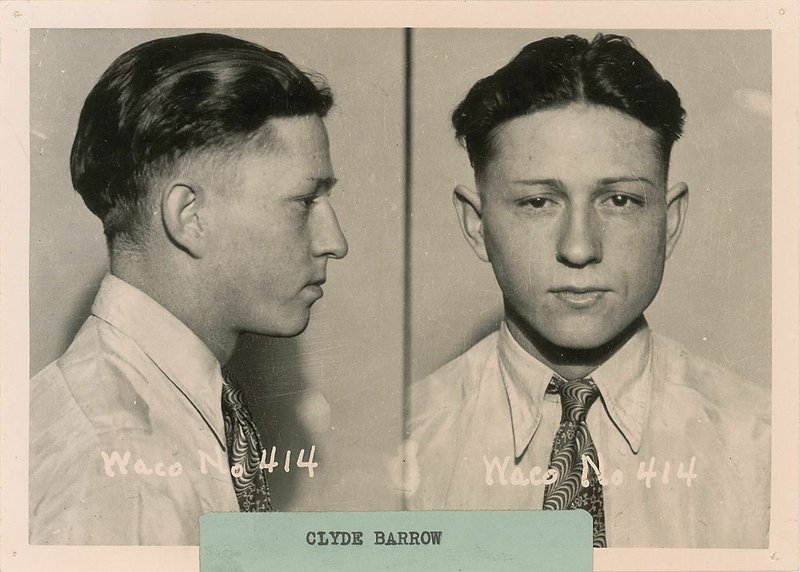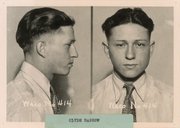FORT SMITH -- Clyde Barrow and W.D. Jones most likely were wearing suits stolen from a Fort Smith tailor in those photographs that became known as the "Joplin rolls," capturing the nation's attention on the front pages of newspapers following a deadly April 1933 shootout with police in Joplin, Mo.
Jeff Hill, a Fort Smith-based truck driver, saw two mentions of the stolen suits in extensive Federal Bureau of Investigation digital files on Bonnie Parker and Clyde Barrow while doing volunteer research for the Fort Smith Museum of History. Hill recently approached the Times Record with information on the suits after seeing an article last month that recalled the tragic June 1933 death of Alma City Marshal Henry Humphrey on U.S. 71 at the hands of "Buck" Barrow with Jones riding "shotgun."
William Daniel Jones, Bonnie and Clyde's 17-year-old sidekick, had been captured by police in the fall of 1933 after nearly a year on the run with the infamous duo. While speaking to FBI Special Agents E.J. Dowd and C.B. Winstead at the Dallas Division Office from Dec. 6-7, 1933, about the automobiles he and the Barrows had stolen, Jones made an off-the-cuff remark that he and Clyde Barrow "'stuck up' a tailor shop early in the morning at Ft. Smith."
"Clyde took a blue suit which he used himself and gave Jones the suit with the wide stripe throwing the other six suits away," the FBI report states. "The negatives of the photographs in question, according to Jones, were left behind together with his striped suit at Joplin, Missouri, after Clyde Barrow, Buck Barrow (deceased) and himself got into a shooting match with the officers at Joplin."
Jones identified himself to the FBI agents in photographs with Clyde Barrow and Bonnie Parker that were taken with a camera Jones said was bought "at the edge of North Carolina" on a trip to Durham, North Carolina.
Whether the photos were taken on the trip to North Carolina, or in Oklahoma, or Missouri, remains in question. The terrain in the background ranges from wooded flatland to rocky, mountainous terrain.
James R. Knight, an Alma native and author of "Bonnie and Clyde: A 21st Century Update," is cautious on the Fort Smith connection to the suits and pointed out that not all of the information in the FBI files, including Jones' testimony, is completely credible.
"Maybe they did steal the suits in Fort Smith," Knight wrote in an email. "Certainly wouldn't be out of character. Both Clyde and Bonnie liked to dress up and have nice clothes."
Brad Belk, executive director of the Joplin Historical & Mineral Museum, said he certainly wouldn't put it past them.
"That's how they made their life," Belk said. "They stole everything and paid for little. They liked to be well-dressed."
Belk said a good resource for him on the Bonnie and Clyde saga has been Jeff Guinn's book "Go Down Together: The True, Untold Story of Bonnie and Clyde." Guinn writes about the outlaws' connection to Fort Smith in several pages of the book, Belk noted.
As for the trip to North Carolina to see the Camel plant -- again, maybe so or maybe not, Knight says. The car in the famous photographs, however, was a V8 sport sedan with leather upholstery and a khaki top with the 1933 Texas plate 587-956. It was in their possession for about 30 days, mid-March to just after the Joplin shootout on April 13, 1933. According to the car's owner, Bob Roseborough of Marshall, Texas, Bonnie and Clyde put about 3,000 miles on it, Knight added.
"Clyde Barrow and Bonnie Parker and Jones traveled in this sport Sedan to Durham, N.C., where Clyde Barrow said he was going to see the Camel Cigarette Factory," the FBI report states. "In the meantime (sic) Clyde Barrow had bought a Brownie Camera for Bonnie Parker and just at the edge of North Carolina, Clyde Barrow, Bonnie Parker and himself took pictures. Jones identified a photograph of himself sitting at the wheel of this sport Sedan, smoking a cigarette."
Knight said he has always thought the pictures were taken somewhere in northeast Oklahoma or southwest Missouri. The Barrows and Jones were certainly back in northeast Oklahoma by March 29-30, since they had met up with Buck and Blanche Barrow there. The FBI report put that meeting Checotah, Okla. They all then went to Joplin, and by April 1, 1933, had rented an apartment there.
Knight surmises the suits were probably stolen from the Fort Smith tailor no later than mid-March. There are credible reports of the Barrows in Texas until the end of December 1932 and early January.
Although there isn't a 1933 Fort Smith city directory at the Fort Smith Public Library, the 1930 and 1936 directories show five tailors working in Fort Smith -- Mrs. Hattie Carl, 518½ Garrison Ave.; S.C. Cohn, 705 Garrison Ave.; L.M. Davila, Four S. Sixth St.; C.A. Wernich, 12 Court St.; and B.A. Wolfe, 26 N. Sixth St.
Hill has long felt it was C.A. Wernich on Court Street who was robbed of the suits, partially based on a 1947 obituary of Carl Albert Wernich that said he sold suits to "businessmen and bank robbers," Hill said. However, Hill was also able to contact a relative of Wernich's in Los Angeles and was told the tailor was known to go into work very early in the morning and was "prideful," so he may not have even reported it to the police.
According to the Court Street address, Wernich's tailor shop would have been in an alley next to the Hotel Main, which abutted First National Bank of Fort Smith. A Cohen Tailor shop, not Cohn as noted in the directory, had also been in the west wing of the Main Hotel, as seen in a 1909 Southwest Times Record photo of the hotel made available by a donation from Joan Wade to the UAFS Pebley Center.
The photographs taken of Jones with Bonnie Parker and Clyde Barrow, according to Jones in the FBI memo, were from undeveloped rolls of film left behind in a two-story garage-apartment at 3347½ Oak Ridge Drive in Joplin. Police thought they were just raiding a bootlegger's house. The Joplin shootout and escape cost Jones a bullet in the side, and his wide stripe suit.
One of Belk's favorite tidbits of trivia related to the shootout is Blanche Barrow's little white dog, Snowball, ran off during the brief shootout. The Joplin museum has several artifacts from that day, including necklaces and a door from the apartment with bullet holes. They also have several reproduction photographs from the "Joplin rolls." Knight pointed out the Joplin Globe developed the rolls of film for police.
The photos that would help other law agencies identify the suspects included the now-iconic image of Bonnie Parker holding a sawed-off shotgun on Clyde Barrow while she reaches for a revolver tucked in his belt. Other photos in that set were of Clyde with his arsenal of stolen guns and Jones in that wide-striped suit, his belt buckle cocked over to his right hip.
Back on the road, Hill doesn't have much time to research the Bonnie and Clyde saga anymore. His six-month hiatus from trucking because of a medical condition more than two years ago was filled with weeks at the library researching the duo's path.
As Hill has noticed, a casual scanning of the FBI files on Bonnie and Clyde will uncover possible evidence of regular visits for the trio in west central Arkansas
Although a Rand McNally's map helped, apparently they knew the back roads well enough to successfully escape the extensive manhunt after the late June 1933 shootout at Alma.
As part of the FBI's investigation into Bonnie and Clyde, a request was sent to the Arkansas State Highway Commission in July 1933 for information on Arkansas license plate 61-132. It was found in an abandoned car assumed to have been stolen by the Barrows. The response from the Arkansas Department of Revenues said the license plate belonged to Maurice Harvey of Waldron. It went on his 1931 Plymouth.
This was just one of many references in the FBI files to the Fort Smith area. Another document uncovered by Hill is a May 3, 1933, letter from Scott County Sheriff and Ex-Officio Collector Theo Money to Ed Portley, chief of detectives for the Joplin police department. Money was responding to a May 2 "circulars and description of the parties that owned the Springfield (sic) rifle."
In the letter, Money tells Portley that Alva Hall, who lives about 18 miles southeast of Waldron "on the highway that goes to Hot Springs" reported that around March 1 "two men accompanied with one woman came his home and told him they had information that they could purchase some whiskey from him, and while they were there one of them noticed his rifle hanging on the wall and they began to try to trade for same."
The letter goes on to say: "They traded him a 22 caliber high power and gave him $7.50 in money ... They were in a coupe and he is not certain just what make it was but said it was equipped with a radio. They also advised him that they lived in DeQueen, Ark."
Money also points out that Hall went to the game warden on the first of April and told him "he had traded his gun off and forgot to take his hunting license out of the stock."
Knight says these accounts fall in among hundreds from both the public and law enforcement -- "intriguing" but probably not provable." Much like the days after the ivory-billed woodpecker was reported in east Arkansas in 2004 after it was thought to be extinct for many years, Bonnie and Clyde sightings were reported every day throughout the Southwest after the Joplin shootout.
NW News on 07/22/2017


